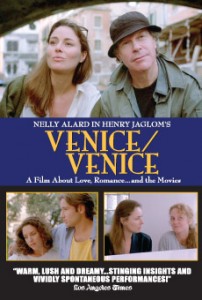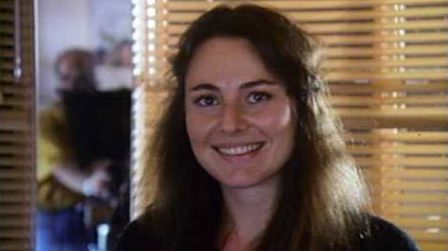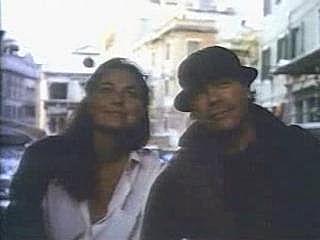From the Chicago Reader (January 22, 1993). –J.R.
VENICE/VENICE
* (Has redeeming facet)
Directed and written by Henry Jaglom
With Jaglom, Nelly Alard, Suzanne Bertish, Melissa Leo, Daphna Kastner, David Duchovny, and Diane Salinger.
Quite early in Venice/Venice writer-director-actor Dean (Henry Jaglom, transparently standing in for himself) tells an interviewer at the Venice film festival that there are two kinds of narcissists. The bad kind love only themselves, but the good kind use their self-love as a stepping-stone to loving others.
Dean (and Jaglom) obviously regards himself as the good kind of narcissist, and clearly we’re supposed to agree. But what about a third kind of narcissist, a kind Dean doesn’t mention — the narcissist whose self-love is a stepping-stone to loving others but who loves others only because he regards them as versions of himself? This is the universe of Henry Jaglom, a new-age, touchy-feely universe where everyone — everyone who matters, that is — talks and thinks and loves and hangs loose in the same manner.
The giveaway of this kind of narcissism is a series of talking-head montages of real-life interviews with women discussing the ways that movies have affected their fantasies about romance. One such montage begins the picture, and others occur again and again throughout. Each woman is framed from the same camera angle in front of venetian blinds (a visual pun?), and Jaglom cuts between these interviews with such rapidity and regularity that all the physical, behavioral, and temperamental differences between the women are obliterated by the obvious similarities in what they’re saying. All of them express, repeatedly, a truism that probably occurs to most people by the time they’ve reached adolescence, though it usually goes on affecting them after that: that romance in real life doesn’t turn out to be like romance in the movies.
One doubts that these real-life women are as unoriginal as Jaglom makes them sound; they just come across that way because he’s reduced them to his obsessive theme — whatever sounds like Henry Jaglom. The same thing applies to Jaglom’s fictional and semifictional characters, most of whom are variations on Jaglom and on each other. While compulsive uniformity of this kind can be found (to lesser degrees) in the work of certain major artists — say, the novels of Faulkner and Dostoyevski and the films of Godard and Cassavetes — these works have emotional, intellectual, thematic, stylistic, and formal ranges that would be unthinkable in a Jaglom movie. He generally shoots without scripts and then spends a lot of time shaping his films at the editing table (he boasts that the editing of Venice/Venice took him two years); the result is an extremely limited repertory of themes and character types, so the usual experience of his movies is roughly akin to watching the filmmaker surrounded by mirrors, loving others and himself and being loved by others and himself with equal fervor.
Jaglom has a second theme — not knowing the difference between life and movies — that is the mirror image of his first. This second theme, however, can only be explored through Jaglom himself — a filmmaker who makes films about his own life — rather than through interviews with other people. Though these others may suffer from the failure of life to live up to movies, they don’t have production companies with camera crews and sound crews at their disposal to capture their expressions of wistful disappointment about this matter.
The first Venice of Venice/Venice is in Italy, where the film festival is held every September. I attended it only once, for three days, in 1980 — during which time I learned that the festival is held on an island called the Lido and that it’s the oldest of all film festivals, created by Mussolini himself. (A huge outdoor cinema with ornate fountains and lights that runs during the festival is a veritable paean to fascist splendor.) None of this is part of Jaglom’s movie; I mention it only to give a rough idea of the sort of things he routinely factors out of his work. The sense of place here is touristic to the point of banality — “romantic” only in the way travel posters are, and not informed by even a whisper of curiosity about the location itself. All that’s relevant is movie-fantasy Venice, complete with motorized gondola and mushy strings, and if Jaglom has any awareness of any other city existing in the same spot he certainly doesn’t show it. As for the festival itself, it could as easily be one festival as another.
When Jaglom had a film in competition at Venice in 1989 he decided to shoot part of a new film there at the same time in which he plays someone with a film in competition at the festival. One of the journalists who interview him is a beautiful young Frenchwoman named Jeanne-Marie (Nelly Alard); she admires and is even obsessed by his work, though she’s a little dismayed to discover he isn’t quite the person she imagined from his films. A romantic relationship develops, but it ends abruptly when he refuses to go with her to see a movie — insisting that he never sees movies at festivals — and then turns up late for a meeting with her afterward; she runs off in tears.
The second Venice is Venice, California, at an unspecified later date — you can’t tell in this locale even what season it is. Dean lives in Venice and has the offices of his production company a few blocks away from his home. Arriving without warning from Paris, Jeanne-Marie heads straight for Dean’s house, where a preproduction party for his next movie is in progress. She has a friendly conversation with Dean’s current live-in lover, Peggy (Melissa Leo), who in classic 60s flower-child style invites Jeanne-Marie to stay over on the sofa and doesn’t seem at all threatened. In the morning, Dean takes Jeanne-Marie along to his office, where he’s shooting interviews with actresses auditioning for the part of his wife in his next picture. Jeanne-Marie gets bored waiting for this process to end and insists on being auditioned herself . . .
The two Venices are only part of the mirror structure underlying this movie. Interspersed throughout both sections, for instance, are the interview sound bites from various women. Toward the end of the movie one realizes that the women auditioning for the part of Dean’s wife, including Jeanne-Marie, are all occupying the same hot seat in front of the venetian blinds we’ve seen before.
I assume Jaglom has an audience for his films, because otherwise he probably wouldn’t go on making and releasing them with such regularity, at least with other people’s money; but it’s a little hard for me to understand who his audiences are. I don’t entirely buy the suggestion made by Dean/Jaglom in one of his festival interviews that he’s appreciated more in Europe than in the States — even if the real-life Alard did make a documentary about him, On the Tracks of a Filmmaker. I’ve never seen Jaglom highlighted at European film festivals or in film magazines, even after nine features, the way that many other American independents with fewer films routinely are. (Jim Jarmusch, for one, was the subject of a special issue of one European film magazine before he completed Stranger Than Paradise, his second feature.)
By induction, I would have to assume that Jaglom’s followers, both here and abroad, are people for whom his two key insights — that most people’s lives aren’t like movies, and that his life is like a movie — are fresh, challenging, and thought-provoking. More likely, they’re people who identify with Jaglom’s upper-class self-absorption or, still likelier, find some glamour or other kind of appeal in his let-it-all-hang-out west-coast milieus.
To be fair, my above synopsis omits several important characters who turn up in both Venices. These include a narcissistic actor (David Duchovny), presumably a bad narcissist, who is jealous of the attention Dean commands for himself and the attention he bestows on actresses and fearful of Dean’s manipulations of his own life; Dean’s former lover and leading lady (Suzanne Bertish), who winds up sleeping with the narcissistic actor, naturally with Dean’s blessing; and Dean’s female assistant (Daphna Kastner), who naturally wants to be an actress herself. Maybe we’re shown so many people who adore Dean that the emotion becomes infectious for some viewers.
I’ve also neglected to mention the elements of conscious self-criticism, comic and otherwise, that undoubtedly figure in Jaglom’s self-portrait; but I believe these elements are rendered ineffectual by his (self-acknowledged) navel gazing, which excludes any interest in a wider social world. I have the same problem, in more intense forms, with the work of Woody Allen and playwright Wallace Shawn, both of whom specialize in a form of sheltered paralysis in which self-love and self-loathing become indistinguishable parts of political abnegation and defeatism. But at least in their cases it’s easier to understand how an audience could identify with the artist’s self-glorifying self-hatred.
Jaglom’s appeal may finally rest on the audience’s lack of exposure to other self-reflexive movies — a type of film that virtually defines much of the French New Wave, American experimental film, and Hollywood movies about movies, ranging from Sullivan’s Travels to The Stunt Man to comedies by Jerry Lewis and Albert Brooks. If you’ve never seen any of these or the hundreds of other modernist movies like them made all over the world, it’s just possible — though not necessarily likely — that you will find Venice/Venice funny and unusual, and thereby help Jaglom make yet another film almost exactly like it.




